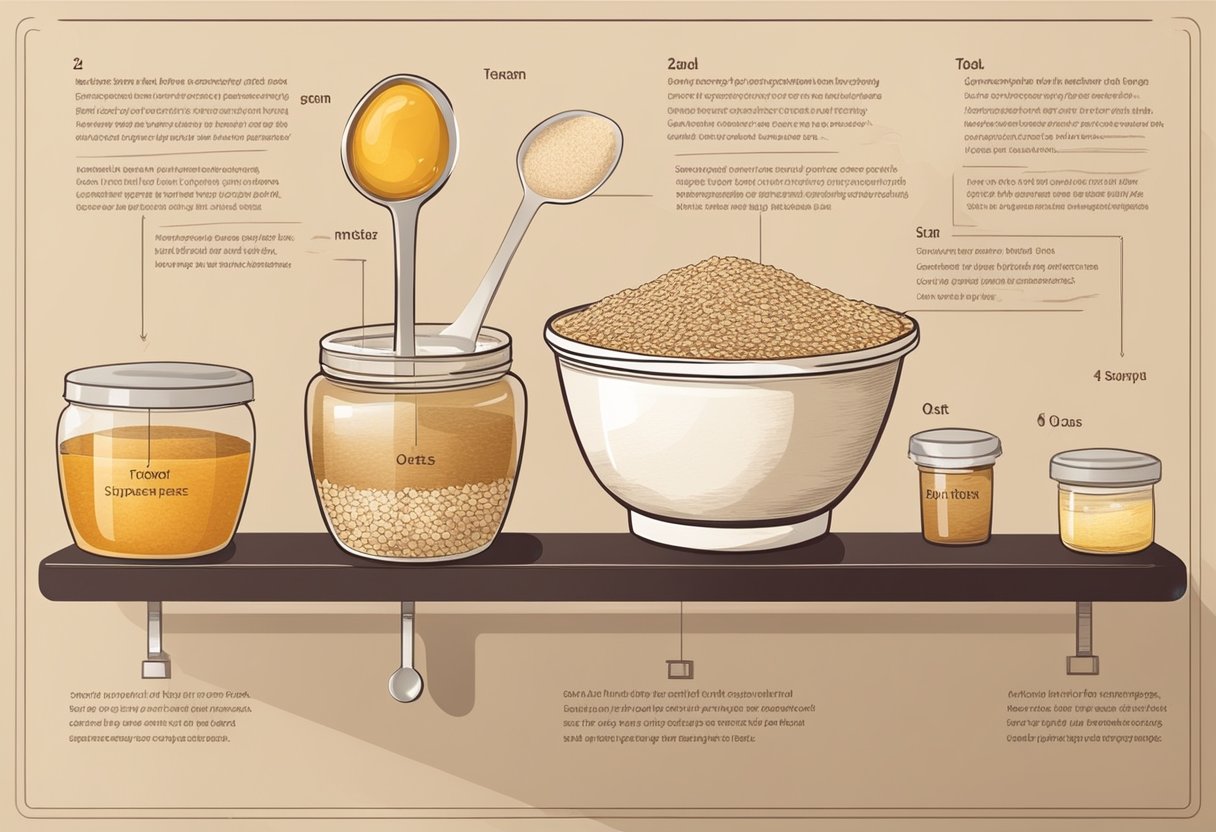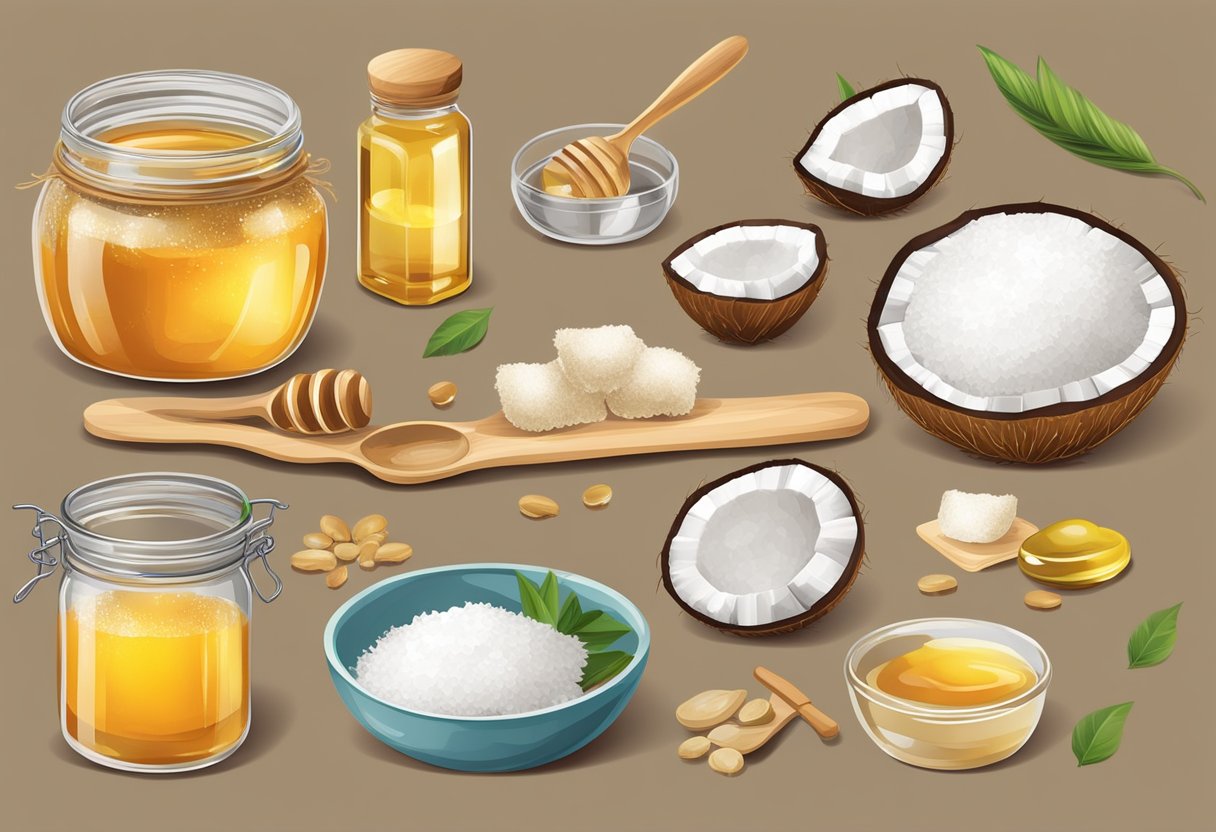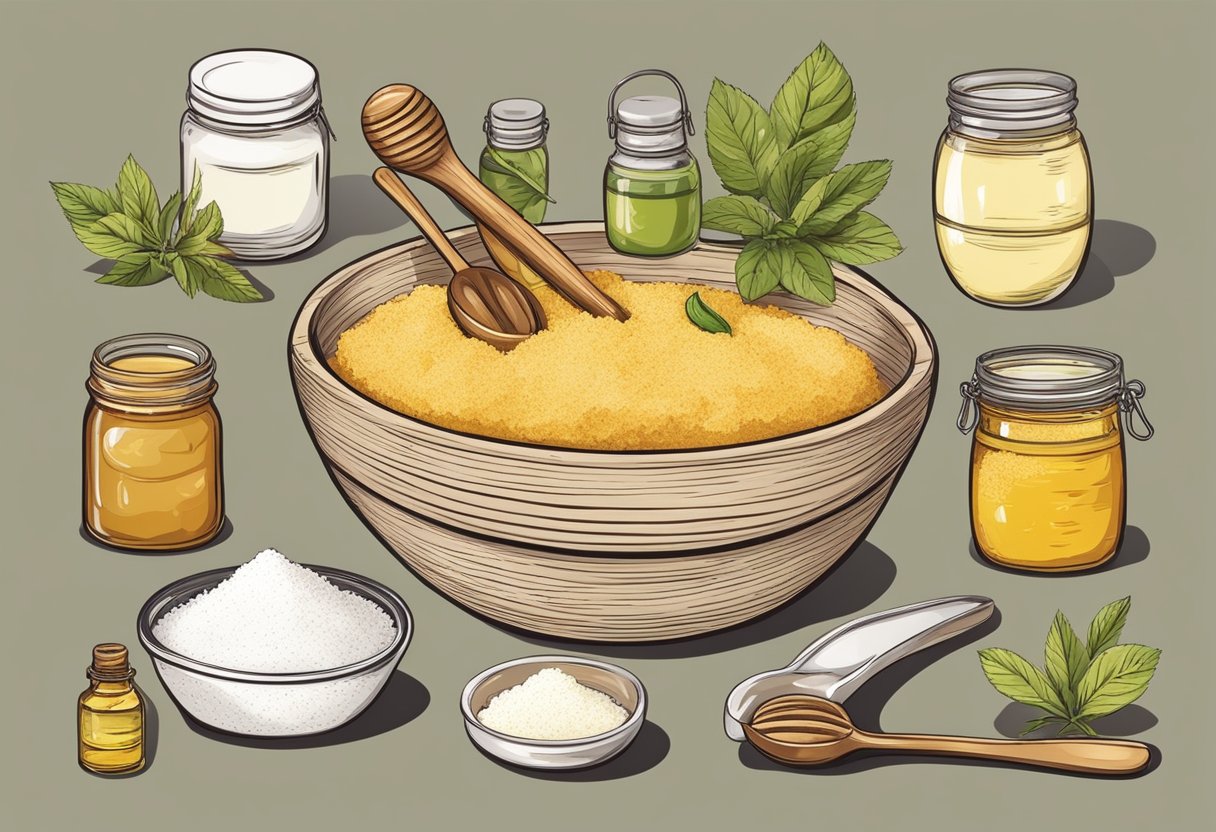Making a homemade face scrub is an easy and affordable way to pamper your skin. A facial scrub can help remove dead skin cells, unclog pores, and leave your skin looking and feeling smoother. With a few simple ingredients that can be found in your kitchen, you can create a personalized face scrub that suits your skin type and needs.

When making a homemade face scrub, it is important to choose ingredients that are gentle on the skin and won’t cause irritation or damage. Common ingredients used in homemade facial scrubs include sugar, salt, coffee grounds, oatmeal, and honey. These ingredients can be combined with carrier oils like coconut or olive oil to create a nourishing and hydrating scrub.
It is also important to consider your skin type when making a homemade face scrub. For example, those with sensitive skin may want to avoid using coarse ingredients like salt or coffee grounds, while those with dry skin may benefit from using a moisturizing ingredient like honey. By customizing your face scrub to your skin type and needs, you can create a gentle and effective skincare routine that leaves your skin looking and feeling its best.
Understanding Skin Types

Identifying Your Skin Type
Before making a homemade face scrub, it is important to understand your skin type. There are four basic types of skin: normal, dry, oily, and combination. Each skin type has its own unique characteristics, and it is important to identify your skin type to ensure that you choose the right ingredients for your homemade face scrub.
Normal skin is well-balanced, with a healthy glow and few blemishes. Dry skin is often flaky, itchy, and prone to fine lines and wrinkles. Oily skin is shiny, with enlarged pores and a tendency to breakouts. Combination skin is a mix of oily and dry areas, with an oily T-zone (forehead, nose, and chin) and dry cheeks.
To identify your skin type, wash your face with a gentle cleanser and wait for an hour. Observe your skin for any changes in texture, oiliness, or dryness. If you have trouble determining your skin type, you can consult a dermatologist or a skincare professional.
Adapting Scrub to Skin Type
Once you have identified your skin type, you can adapt your homemade face scrub to suit your needs. For normal skin, a gentle scrub made with sugar or salt and a moisturizing ingredient like honey or olive oil can help to exfoliate and nourish the skin.
For dry skin, it is important to choose an exfoliant that is gentle and hydrating. A scrub made with oatmeal, yogurt, and honey can help to soothe and moisturize dry skin.
For oily skin, a scrub made with astringent ingredients like lemon juice, tea tree oil, or witch hazel can help to control oil production and prevent breakouts. A scrub made with sugar or salt and a light oil like jojoba or grapeseed oil can help to balance the skin’s natural oils.
For combination skin, a scrub made with a gentle exfoliant like oatmeal or sugar and a moisturizing ingredient like honey or avocado can help to balance the skin’s oil production and prevent dryness.
In summary, choosing the right ingredients for your homemade face scrub can help to keep your skin healthy, glowing, and beautiful. By identifying your skin type and adapting your scrub to suit your needs, you can achieve the best results for your skin.
Benefits of Homemade Face Scrubs

Homemade face scrubs have become increasingly popular in recent years due to their numerous benefits. Here are some of the benefits of using homemade face scrubs:
Natural Ingredients
One of the main benefits of using a homemade face scrub is that it contains natural ingredients. Unlike store-bought face scrubs that often contain harsh chemicals, homemade face scrubs are made with natural ingredients that are gentle on the skin. Natural ingredients such as honey, oatmeal, and coconut oil have been shown to have numerous benefits for the skin, including moisturizing, soothing, and exfoliating.
Customization
Another benefit of making your own face scrub is that you can customize it to suit your skin type and specific needs. For example, if you have oily skin, you can make a face scrub with ingredients that help to control oil production. If you have dry skin, you can make a face scrub with ingredients that help to hydrate and moisturize the skin. By customizing your face scrub, you can ensure that it is tailored to your unique skin type and needs.
Cost-Effectiveness
Making your own face scrub is also cost-effective. Many store-bought face scrubs can be quite expensive, especially if you use them regularly. By making your own face scrub, you can save money and still enjoy the benefits of exfoliating your skin. Homemade face scrubs can be made with ingredients that are readily available in most kitchens, making them an affordable option for anyone looking to improve their skin’s health and appearance.
In conclusion, homemade face scrubs are an excellent choice for anyone looking to improve their skin’s health and appearance. By using natural ingredients, customizing the scrub to suit your skin type and needs, and saving money in the process, homemade face scrubs are a great addition to any skincare routine.
Essential Ingredients

When it comes to making a homemade face scrub, there are a few essential ingredients that you’ll want to include. These ingredients will help to exfoliate your skin, remove dead skin cells, and leave your skin feeling soft, smooth, and refreshed.
Exfoliants
The first essential ingredient for any homemade face scrub is an exfoliant. This is the ingredient that will help to remove dead skin cells and reveal the fresh, healthy skin underneath. Some great options for exfoliants include:
- Sugar: A gentle exfoliant that is great for sensitive skin.
- Salt: A coarser exfoliant that is better for tougher skin.
- Coffee grounds: A great option for those who want to reduce puffiness and dark circles under their eyes.
Carriers and Oils
The next essential ingredient for a homemade face scrub is a carrier or oil. This ingredient will help to moisturize your skin and leave it feeling soft and smooth. Some great options for carriers and oils include:
- Coconut oil: A great all-purpose carrier oil that is great for most skin types.
- Olive oil: A heavier carrier oil that is better for dry or mature skin.
- Jojoba oil: A lightweight carrier oil that is great for oily or acne-prone skin.
Additional Beneficial Additives
Finally, you may want to consider adding some additional beneficial additives to your homemade face scrub. These can include things like:
- Honey: A natural humectant that helps to lock in moisture.
- Lemon juice: A natural astringent that can help to tighten pores and brighten skin.
- Essential oils: These can be added for fragrance or for their specific skin benefits. Some great options include lavender, tea tree, and peppermint oil.
By including these essential ingredients in your homemade face scrub, you can create a product that is tailored to your specific skin type and needs. Plus, making your own face scrub is a fun and cost-effective way to pamper yourself and take care of your skin.
Creating Your Scrub

When making a homemade face scrub, it is important to select ingredients that are suitable for your skin type and concerns. The following subsections will provide guidance on selecting your ingredients, mixing techniques, and achieving the desired consistency and texture.
Selecting Your Ingredients
There are many ingredients that can be used to create a homemade face scrub, including sugar, coffee grounds, oats, and sea salt. Each ingredient has its own unique properties, so it is important to choose ingredients that will address your specific skin concerns.
For example, sugar is a gentle exfoliant that is suitable for all skin types, while sea salt is a more abrasive exfoliant that is best suited for oily skin. Coffee grounds contain caffeine, which can help to reduce inflammation and puffiness, making it a good choice for those with sensitive skin.
Other ingredients to consider include honey, which has antibacterial properties, and essential oils, which can provide additional benefits such as hydration and relaxation.
Mixing Techniques
When mixing your ingredients, it is important to ensure that they are well combined to create a uniform consistency. One method is to mix the ingredients in a bowl using a spoon or spatula. Another method is to use a blender or food processor to create a smoother texture.
It is also important to consider the order in which the ingredients are added. For example, if using honey, it should be added last to avoid clumping.
Consistency and Texture
The consistency and texture of your face scrub will depend on the ingredients used and the mixing technique. As a general rule, the scrub should be thick enough to stay on the skin without dripping, but not so thick that it is difficult to spread.
If the scrub is too thick, additional liquid such as water or oil can be added to thin it out. If the scrub is too runny, additional dry ingredients such as sugar or coffee grounds can be added to thicken it up.
By following these guidelines for selecting ingredients, mixing techniques, and achieving the desired consistency and texture, you can create a homemade face scrub that is tailored to your specific skin needs.
Application Tips

Pre-Scrub Skin Preparation
Before using any homemade face scrub, it is important to prepare your skin. Start by washing your face with a gentle cleanser to remove any makeup or dirt. Pat your skin dry with a clean towel. If you have sensitive skin, it is recommended to perform a patch test before using any new product. Apply a small amount of the scrub to your inner wrist or behind your ear and wait for any adverse reactions.
Scrubbing Technique
When applying the scrub, use gentle circular motions with your fingertips. Avoid scrubbing too hard or using excessive pressure, as this can cause skin irritation and redness. Pay extra attention to areas that are prone to blackheads and whiteheads, such as the nose and chin. It is recommended to scrub for no more than 2-3 minutes to avoid over-exfoliating the skin.
Post-Scrub Care
After using the scrub, rinse your face thoroughly with lukewarm water and pat dry with a clean towel. It is important to follow up with a moisturizer to keep your skin hydrated. Avoid using any harsh products or exfoliants on your skin for at least 24 hours after using the scrub to prevent further irritation. If you experience any redness or discomfort, apply a cold compress to the affected area for a few minutes.
By following these application tips, you can ensure that your homemade face scrub is effective and safe for your skin. Remember to always use high-quality ingredients and avoid any irritants or allergens.
Storage and Preservation

Container Choices
When it comes to storing homemade facial scrubs, the container choice is crucial. The container should be clean, dry, and airtight to prevent contamination and extend the shelf life of the scrub. Glass jars with tight-fitting lids are a great option as they are non-reactive and won’t leach chemicals into the scrub. Plastic containers are also a good option, but they should be made of high-quality plastic that won’t react with the ingredients. It’s best to avoid metal containers as they can react with the ingredients and cause oxidation.
Shelf Life
The shelf life of a homemade facial scrub depends on the ingredients used and the storage conditions. Generally, homemade facial scrubs can last up to three months if stored properly in a cool, dry place away from direct sunlight. However, some ingredients like fresh fruits and vegetables have a shorter shelf life and should be used within a week. It’s important to note that homemade facial scrubs don’t contain preservatives like store-bought scrubs, so they should be used within a reasonable amount of time to prevent spoilage.
To extend the shelf life of homemade facial scrubs, it’s recommended to store them in the refrigerator. This will help slow down the growth of bacteria and prevent spoilage. Additionally, it’s important to use clean hands or a spatula to scoop out the scrub to prevent contamination.
In summary, choosing the right container and storing the homemade facial scrub properly can help extend its shelf life. It’s important to use clean hands or a spatula to scoop out the scrub and store it in a cool, dry place away from direct sunlight. Following these tips can help ensure that the homemade facial scrub stays fresh and effective for as long as possible.
Troubleshooting Common Issues

Skin Reactions
Using a homemade face scrub can be a great way to exfoliate and rejuvenate your skin, but it’s important to be aware of potential skin reactions. Some people may experience redness, irritation, or even breakouts after using a face scrub. If you experience any of these reactions, there are a few things you can do to troubleshoot the issue.
First, make sure that you’re not using ingredients that you’re allergic or sensitive to. Common allergens include nuts, dairy, and gluten, so be sure to check the ingredients of any homemade face scrub recipe you use.
If you’re not allergic to any of the ingredients, try using a gentler scrub or reducing the frequency of use. Over-exfoliating can cause irritation and breakouts, so it’s important to find a balance that works for your skin.
Adjusting Abrasiveness
Another common issue with homemade face scrubs is getting the right level of abrasiveness. Some scrubs may be too harsh for sensitive skin, while others may not be abrasive enough to effectively remove dead skin cells.
If you find that your scrub is too abrasive, try using a finer grain or reducing the amount of scrubbing time. You can also add more moisturizing ingredients like honey or avocado to help soothe and hydrate your skin.
On the other hand, if your scrub isn’t abrasive enough, try using a coarser grain or increasing the amount of scrubbing time. Just be sure to pay attention to your skin’s reaction and adjust accordingly.
By troubleshooting these common issues, you can create a homemade face scrub that works for your unique skin type and needs.
Frequently Asked Questions

What natural ingredients can be used to create an effective face scrub for glowing skin?
There are many natural ingredients that can be used to create an effective face scrub for glowing skin. Some of the most popular ones include sugar, honey, lemon, oatmeal, and coffee grounds. These ingredients are known for their exfoliating and moisturizing properties, which help to remove dead skin cells and reveal brighter, smoother skin.
How can I formulate a sugar scrub suitable for facial skin?
To formulate a sugar scrub suitable for facial skin, you can mix 1 tablespoon of sugar with 1 tablespoon of olive oil or coconut oil. Gently massage the mixture onto your face in a circular motion, then rinse with warm water. Sugar is a gentle exfoliant that helps to remove dead skin cells, while olive oil or coconut oil helps to moisturize and soothe the skin.
What recipe can I follow to make a turmeric scrub for acne-prone skin?
To make a turmeric scrub for acne-prone skin, you can mix 1 tablespoon of turmeric powder with 1 tablespoon of honey and 1 tablespoon of yogurt. Apply the mixture to your face and leave it on for 10-15 minutes, then rinse with warm water. Turmeric has anti-inflammatory properties that can help to reduce redness and inflammation associated with acne, while honey and yogurt help to moisturize and soothe the skin.
Can you recommend a gentle homemade scrub for sensitive facial skin?
For sensitive facial skin, it is important to use gentle ingredients that will not irritate or damage the skin. Some gentle homemade scrub options include oatmeal, honey, and chamomile tea. To make an oatmeal scrub, mix 1 tablespoon of oatmeal with 1 tablespoon of honey and apply to your face in a circular motion. Rinse with warm water. Chamomile tea can be used as a gentle toner after exfoliating to soothe and calm the skin.
What are the best practices for exfoliating dry skin with a homemade scrub?
When exfoliating dry skin with a homemade scrub, it is important to use gentle ingredients that will not further dry out or damage the skin. Some effective ingredients for exfoliating dry skin include brown sugar, coconut oil, and avocado. To make a brown sugar scrub, mix 1 tablespoon of brown sugar with 1 tablespoon of coconut oil and massage onto your face in a circular motion. Rinse with warm water. Avocado can be mashed and applied to the face as a moisturizing mask after exfoliating.
Which homemade scrubs work well for combination skin without causing irritation?
For combination skin, it is important to use ingredients that will balance the skin without causing irritation or over-drying. Some effective ingredients for combination skin include oatmeal, honey, and green tea. To make an oatmeal scrub, mix 1 tablespoon of oatmeal with 1 tablespoon of honey and apply to your face in a circular motion. Rinse with warm water. Green tea can be used as a toner after exfoliating to help balance the skin.

